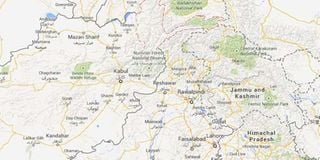350 dead, hundreds missing in Afghan landslide

A map showing Badakhshan Province, Afghanistan.
What you need to know:
- Abdullah Homayun Dehqan, provincial director of the Afghan National Disaster Management Authority cautioned that the death toll remained uncertain, after Badakhshan governor Shah Waliullah Adeeb said that 2,500 people could have been killed
AAB BAREEK
Rescuers searched for survivors on Saturday after a landslide buried an Afghan village, killing 350 people and leaving hundreds of others feared dead amid warnings that more earth could sweep down the hillside.
Local people tried to dig out victims trapped under a massive river of mud that engulfed Aab Bareek village in Badakhshan province where little sign remained of hundreds of destroyed homes.
The United Nations confirmed that 350 people were dead, and provincial officials said more than 2,000 could be still missing 24 hours after the disaster.
Emergency workers arrived on Saturday morning to be confronted by the enormous scale of the landslide and hundreds of homeless families.
"There is a very thick layer of mud. It is very difficult for people to take dead bodies out," Sayed Abdullah Homayun Dehqan, provincial director of the Afghan National Disaster Management Authority, told AFP from the scene.
"There is fear of another landslide. Our assessment team have seen a crack in a nearby hill.
"They have only been able to find the body of a woman and a man.
"We have started distributing food... but we don't have enough tents for all the 700 families who spent the night outside. There are around 2,000 people - women, children, elders - without homes."
Dehqan cautioned that the death toll remained uncertain, after Badakhshan governor Shah Waliullah Adeeb said that 2,500 people could have been killed.
The site is expected to be designated a mass grave and memorial services have been planned for later Saturday.
Villagers were at Friday prayers in two mosques when they were entombed by a tide of debris, and a second landslide hit many who had rushed to assist those in need.
FOOD, SHELTER NEEDED
"All the relevant UN agencies - together with the Afghan Red Crescent Society and NGO partners - are already on the ground," the UN mission in Afghanistan said.
"The immediate focus is on approximately 700 families displaced either directly as a result of this slide or as a precautionary measure from villages assessed to be at further risk.
"Key needs for them are water, medical support, counselling support, food and emergency shelter."
President Hamid Karzai expressed his condolences to those affected and said immediate action was being taken to find survivors.
But large-scale rescue work could be impossible as roads to the area cannot take heavy machinery.
Badakhshan is a remote, mountainous province in northeast Afghanistan bordering Tajikistan, China and Pakistan.
It has been relatively peaceful since the US-led military intervention began in 2001, but has seen increasing Taliban activity in recent years.
Local officials said that the landslides occurred at about midday (07:30 GMT) in the Argo district of Badakhshan after days of heavy rain.
Between 350 and 400 houses were destroyed, they said.
US President Barack Obama described the deaths as "an awful tragedy" and pledged to help the relief effort.
The landslides follow recent severe flooding in other parts of northern Afghanistan, with 150 people dead and 67,000 people affected by floods in Jowzjan, Faryab and Sar-e-Pul provinces.
Nearly 3,500 houses were damaged and destroyed by the floods.
Flooding and landslides often occur during the spring rainy season in northern Afghanistan, with flimsy mud houses offering little protection against rising water levels and torrents of mud.
In the last major flooding in Afghanistan, 40 people died in August in flash floods in eastern and southeastern provinces and some districts of the capital Kabul.
Afghanistan is in the middle of presidential elections, with former foreign minister Abdullah Abdullah and ex-World Bank economist Ashraf Ghani due to compete in a head-to-head vote on June 7.
Preliminary results from the first round of elections on April 5, in which eight candidates ran, showed no one gained the 50 percent needed for a decisive victory.




